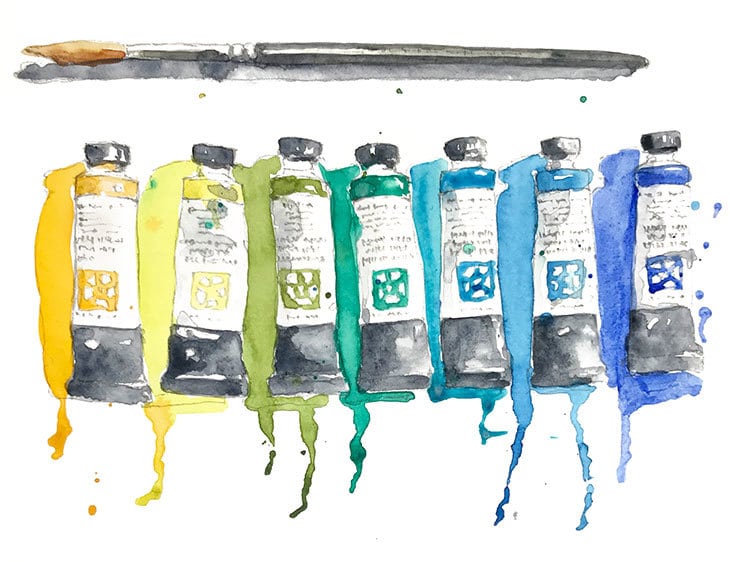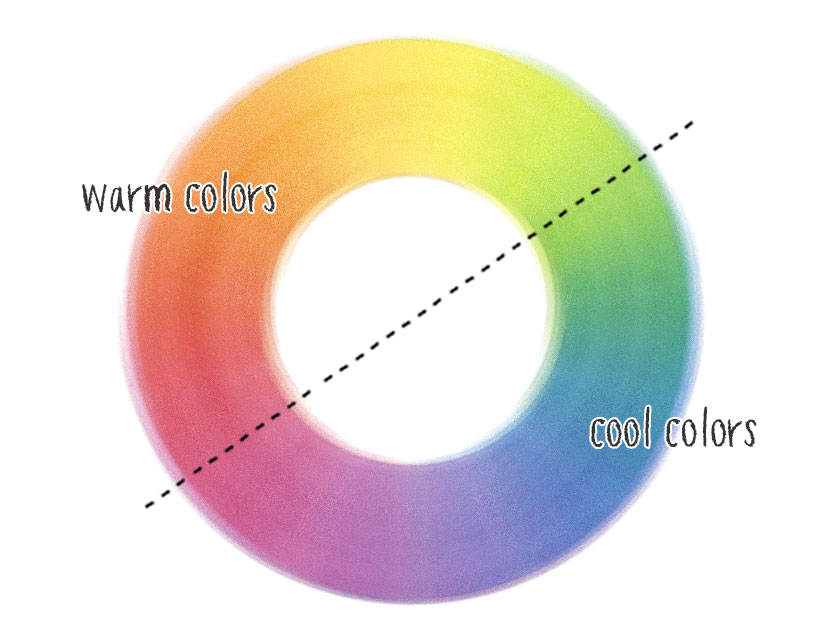
How to Choose The Perfect Palette & Save On Supplies
This lesson is a big win for several reasons!
- It’ll save you money…
- It’ll improve your color mixing skills faster…
- You can produce a huge range of colors from just a handful of paints…
- Making the right choice will improve your glazing technique…
- It’ll make it easier for you to understand and match the colors you want, thanks to my ‘Magic Palette Method’ !
So what am I talking about?
If you’ve read other articles on my blog you might have heard me recommend the following:
“The fundamental basis of any watercolor mixing palette should include transparent paints, and a warm and cool version of each primary color”
Like this for example:

This isn’t just another “go get these paints” article…
No… This is a carefully selected range of pigments and hues, to make you a more successful watercolor painter. Because paints like these let you do all the wonderful things I listed above 🙂
All , just by choosing the right paints to get started!
(Or… if you already have some paints, by carefully setting up your color palette, and using very little else…)
If you’ve ever spent time choosing your watercolor paints, you’ll know this – The choice is mind boggling !
Which colors should you choose to begin painting in watercolors?
Once you’ve got over the hurdle of which brand and which format (tubes or pans), you then have to choose from a range of hundreds of different hues! (I recommend tubes, by the way)
At first it can seem overwhelming. I know this because I took a loooong time to choose my first watercolors after researching all kinds of options.
But to cut a long story short, if you were to start with only a few colors, you should probably use a limited palette of just 8 paints to begin with…
Start with the warm and cool version of each primary color that I mentioned above. That gives you six colors to begin with.
To these six paints I would add two more fundamental colors.
The first is Burnt Umber.

Burnt Umber is probably one of the best mixing colors you can add to your collection.
When you mix Burnt Umber and Ultramarine Blue you get a wonderfully intense black, and some interesting grays. Add more blue for cool grays and more Burnt Umber for warm neutral hues. Burnt umber is the basis of many earthy tones and neutrals. It’s also a great base color for skin tones…
The other color I would recommend is Phthalo Green BS. (Blue shade)

On its own this single pigment paint produces a fairly unreal vivid green. But it can easily be adjusted by blending with other paints to make a very versatile range of greens. Including some very natural green hues suitable for landscapes, or turquoise blues for ocean scenes.
1. Saves money
There are only 8 paints in this limited palette. But this is all you need to mix just about any color you want (see the example chart lower down!).
You can always build your collection of paints over time. For example, many artists pick up some “convenience” mixtures. These paints combine 2 or more pigments to produce a specific hue – it’s like having a ready-made mix of your favorite color 🙂
But to get started, you don’t need to spend a lot of money on a vast selection of paints to get the results you need.
2. Improve your color mixing skills faster
Color mixing is a skill that evolves over time. Little by little you’ll become familiar with your paints and what mixtures to use to produce a particular hue.
But if you’re trying to master color mixing with dozens of paint choices, it’s going to take a long time to get to grips with this painting skill!
Limited palettes (and limited choices) lead to a faster understanding of paint mixing.
3. Produce a huge range of colors with just a few paints.
Equipped with these paints you can easily mix an amazing variety of bright and subdued secondary colors, grays, a wonderful assortment of greens, and lots more !
Just look at the range of possibilities in the color mixing chart I made using these 8 paints:

The squares in this chart combine equal amounts of each paint from the horizontal and vertical axis. The upper right side shows strong mixes, and the lower left side shows diluted mixtures. Imagine the scope possibilities when mixing different proportions of each paint, or more than two paint colors!
4. Choosing wisely will improve your glazing technique!
All of the paints in this list are what watercolorists refer to as “single pigment” paints.
I mentioned “convenience” mixtures earlier, which are a blend or more than one pigment.
So, you guessed it… single pigment paints only have one pure pigment in their ingredients. This characteristic makes them better suited to glazing and layering techniques in watercolor. You can layer them without worrying about muddying the colors, resulting in cleaner and more vibrant glazes.
(please note, this list links to Blicks art store)
- Hansa Yellow Deep – Pigment number: PY65
- Lemon yellow – Pigment number: PY175
- Phthalo blue GS – Pigment number: PB15:3
- French ultramarine – Pigment number: PB29
- Quinacridone rose – Pigment number: PV19
- Pyrrol scarlet – Pigment number: PR255
- Burnt umber – Pigment number: PBr7
- Phthalo Green BS – Pigment number: PG7
If you’re not sure what Glazing is: One of the properties of watercolors is that they are transparent. This transparency is what makes it possible to “glaze” in watercolor. Glazing means applying a thin layer of paint over a previously dried layer of watercolor to create subtle color changes and deeper hues.

So it’s wise to start out with single pigment paint options if you want to optimize glazing.
My list of paints above refer to Daniel Smith paint names and pigment numbers. These are my personal recommendations. But I know not everyone uses the same brand as me 🙂
In my previous email I promised you a bonus – so here it is!
This downloadable PDF guide will help you to match paint colors from other brands, so you can take my suggestions, and find equivalents in your own preferred brand…
5. Makes it easier and quicker to match colors when mixing
This final benefit stems from the use of both warm and cool primary colors.
Warm and cool colors are terms used in painting to describe the overall “temperature” of a color. Warm colors are those that typically remind us of warmth, like reds, oranges, and yellows. Cool colors, on the other hand, are colors that remind us of coolness, such as blues, greens, and purples.

Having both warm and cool colors in your watercolor palette is essential because when mixed, they give different results!
For example, a warm blue mixed with a warm yellow produces an entirely different green, compared to mixing cool blues and yellows (Look carefully again at the mixing chart above and you’ll see this for yourself).
Try putting this limited palette to use for yourself. You’ll begin to understand mixing rules much more easily.
Also, in a couple of days, I’ll reveal the secrets of my “Magic Palette Method,” a technique that will completely transform the way you use warm and cool colors to mix paints!
Get ready to boost your art to new heights!
Happy Painting !
Anthony
P.S. (IMPORTANT) If you enjoyed this and want more I strongly suggest you “whitelist” my email address (which is [email protected]). Recently, Gmail and some others have started blocking important emails because of updates to their spam filters. I will not spam you. And you can unsubscribe any time you want. I will, however, send you promotions for my watercolor courses… Please note that any purchase is entirely discretionary. Everything else is free. So if you want to keep receiving my painting tips, please put my email in your “safe senders” list. And to find out how to do this, read this page…
